Are feather stars poisonous ideas
Home » Wallpapers » Are feather stars poisonous ideasYour Are feather stars poisonous images are available in this site. Are feather stars poisonous are a topic that is being searched for and liked by netizens now. You can Find and Download the Are feather stars poisonous files here. Get all royalty-free vectors.
If you’re looking for are feather stars poisonous images information related to the are feather stars poisonous topic, you have come to the right blog. Our website frequently gives you hints for viewing the maximum quality video and image content, please kindly surf and find more informative video content and graphics that match your interests.
Are Feather Stars Poisonous. Here they extend their arms into the currents and gather food. These are species of sea stars Asteroids brittle stars Ophiuroids sea urchins Echinoids sea liliesfeathers Crinoids and sea cucumbers Holothuroids. The species Antedon bifida known as the Rosy Feather Star occurs most frequently between Scotland and Portugal. These creatures come in a great range of colors including some bright yellows and reds perhaps to ward off predators mistaking them to be poisonous.
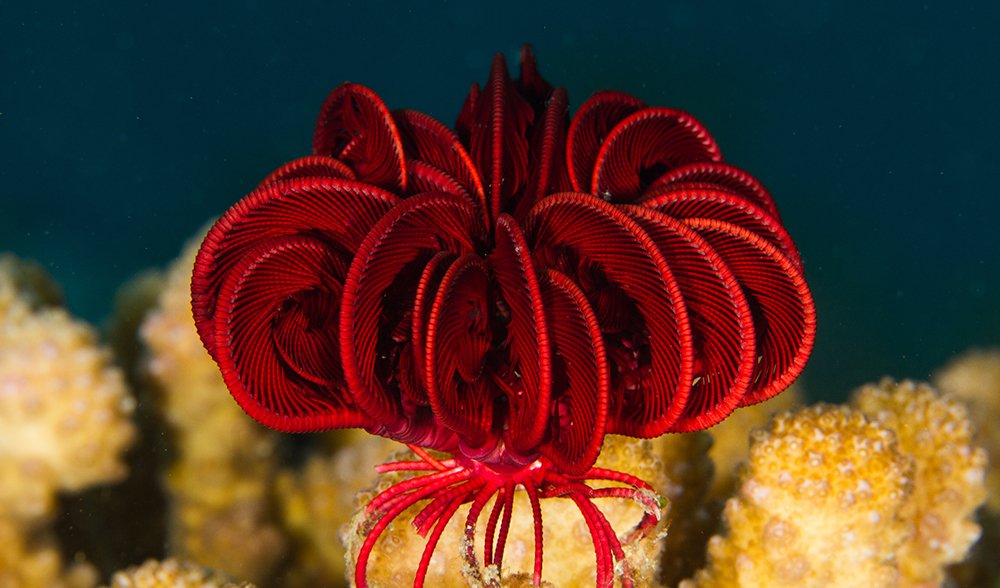 Feather Stars Are The Closest Thing We Have To Walking Plants Australian Geographic From australiangeographic.com.au
Feather Stars Are The Closest Thing We Have To Walking Plants Australian Geographic From australiangeographic.com.au
Feather stars are usually perched on top of tall living or dead hard corals sponges and other sturdy anchors. Sydney is home to about 120 species of echinoderms and because of their size and unusual shapes they are one. The dropped arm may continue to wriggle to distract the predator while the brittle star escapes. A feather stars body consists of a basal plate known as the calyx which bears a number of specialized cirri that are used for holding onto rocks or other objects when the animal is feeding or at rest. Both the mouth and the anus of the Feather Star are centrally located at the top of the animal and food is passed down to its mouth using the feathery arms. Crinoid Shrimp Crinoid Clingfish and Squat Lobsters take refuge in the arms of Feather Sea Star and also eat the left over food of the sea star.
They would make striking display organisms but their specialised diets hamper success in the home aquarium.
Some feather stars are also toxic helping them avoid getting eaten. But because small animals like snails often live on them fish may comb through feather stars looking for. Feather stars can still anchor themselves to rocks and substrate if they need to using a set of tiny legs called cirri. Here are five of the most beautiful species from around the world. These are species of sea stars Asteroids brittle stars Ophiuroids sea urchins Echinoids sea liliesfeathers Crinoids and sea cucumbers Holothuroids. There are some winners in such catastrophic conditions actually.
 Source: earthbuddies.net
Source: earthbuddies.net
These creatures come in a great range of colors including some bright yellows and reds perhaps to ward off predators mistaking them to be poisonous. The bright colors displayed by many feather stars signal distasteful qualities. Feather Sea Star is non-poisonous in nature. A feather stars body consists of a basal plate known as the calyx which bears a number of specialized cirri that are used for holding onto rocks or other objects when the animal is feeding or at rest. It prefers to grow between the low tide mark.
 Source: okdiversbali.com
Source: okdiversbali.com
Magnus Deep Below Those lovely fringed arms are covered in tiny mucous-secreting tube feet that can move independently of each other and this allows the feather stars to catch plankton and other microscopic morsels floating through the water. The mouth is situated on the upper surface of the calyx. Their general feeding strategy consists of capturing and transferring tiny plankton such as phytoplankton invertebrate larvae and detrital particulates. Sydney is home to about 120 species of echinoderms and because of their size and unusual shapes they are one. Feather Sea Star is non-poisonous in nature.
 Source: okdiversbali.com
Source: okdiversbali.com
All are found in the marine environment in a range of habitats from intertidal surf beaches to the deepest oceans. Feather stars are echinoderms like the more familiar sea stars. Feather stars can still anchor themselves to rocks and substrate if they need to using a set of tiny legs called cirri. Here they extend their arms into the currents and gather food. The crinoids or Feather stars are the Dendronephthya of the echinoderm world.
 Source: okdiversbali.com
Source: okdiversbali.com
The crinoids or Feather stars are the Dendronephthya of the echinoderm world. But because small animals like snails often live on them fish may comb through feather stars looking for. A feather star has 10 to 120 arms and they spend most of their lives clinging to rocks coral or other hard surfaces. These are species of sea stars Asteroids brittle stars Ophiuroids sea urchins Echinoids sea liliesfeathers Crinoids and sea cucumbers Holothuroids. The crinoids or Feather stars are the Dendronephthya of the echinoderm world.
 Source: okdiversbali.com
Source: okdiversbali.com
The echinoderms Greek for spiny skin include sea stars sea urchins feather stars brittle stars and sea cucumbers. A feather star has 10 to 120 arms and they spend most of their lives clinging to rocks coral or other hard surfaces. The mouth is situated on the upper surface of the calyx. Some feather stars are also toxic helping them avoid getting eaten. These creatures come in a great range of colors including some bright yellows and reds perhaps to ward off predators mistaking them to be poisonous.
 Source: earthbuddies.net
Source: earthbuddies.net
Crinoid Shrimp Crinoid Clingfish and Squat Lobsters take refuge in the arms of Feather Sea Star and also eat the left over food of the sea star. The dropped arm may continue to wriggle to distract the predator while the brittle star escapes. The bright colors displayed by many feather stars signal distasteful qualities. Some feather stars are also toxic helping them avoid getting eaten. The crinoids or Feather stars are the Dendronephthya of the echinoderm world.
 Source: factsanddetails.com
Source: factsanddetails.com
Feather stars can still anchor themselves to rocks and substrate if they need to using a set of tiny legs called cirri. Magnus Deep Below Those lovely fringed arms are covered in tiny mucous-secreting tube feet that can move independently of each other and this allows the feather stars to catch plankton and other microscopic morsels floating through the water. The species Antedon bifida known as the Rosy Feather Star occurs most frequently between Scotland and Portugal. They have skin toxins which serve as a deterrent. A feather star has 10 to 120 arms and they spend most of their lives clinging to rocks coral or other hard surfaces.
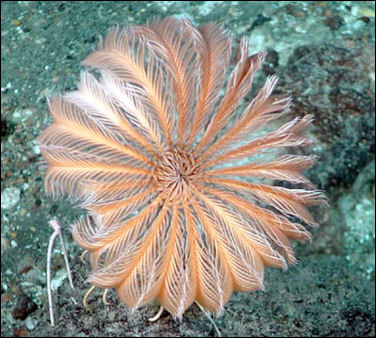 Source: factsanddetails.com
Source: factsanddetails.com
Feather stars have multiple arms. These creatures come in a great range of colors including some bright yellows and reds perhaps to ward off predators mistaking them to be poisonous. The species Antedon bifida known as the Rosy Feather Star occurs most frequently between Scotland and Portugal. Feather stars are usually perched on top of tall living or dead hard corals sponges and other sturdy anchors. Feather stars have multiple arms.
 Source: australiangeographic.com.au
Source: australiangeographic.com.au
Each branch in turn is covered with feathery pinnules extending from the sides with the pinnules being studded with tiny tube feet. Five primary limbs extend from the central disk and then branch with the total number reaching as many as 120 depending on the species and the stage of growth. They have skin toxins which serve as a deterrent. What yucky yet effective defense mechanism do sea cucumbers have when they shoot out their poisonous intestines to deter predators. The Himerometra species is Nocturnal in nature and therefore hides beneath sponges corals rocks andor rock caves or any other shady region during the day time while being active at night.
 Source: youtube.com
Source: youtube.com
However not every single living being is feeling threatened actually. What yucky yet effective defense mechanism do sea cucumbers have when they shoot out their poisonous intestines to deter predators. Rosy Feather Star via flickrPhilippe Guillaume. But because small animals like snails often live on them fish may comb through feather stars looking for a tasty meal. The echinoderms Greek for spiny skin include sea stars sea urchins feather stars brittle stars and sea cucumbers.
 Source: pinterest.com
Source: pinterest.com
Their general feeding strategy consists of capturing and transferring tiny plankton such as phytoplankton invertebrate larvae and detrital particulates. Also arising from this small body are the jointed arms which are usually quite short but may measure more than 118 in 30 cm in some. These are species of sea stars Asteroids brittle stars Ophiuroids sea urchins Echinoids sea liliesfeathers Crinoids and sea cucumbers Holothuroids. Feather stars can still anchor themselves to rocks and substrate if they need to using a set of tiny legs called cirri. But because small animals like snails often live on them fish may comb through feather stars looking for.
 Source: xray-mag.com
Source: xray-mag.com
These creatures come in a great range of colors including some bright yellows and reds perhaps to ward off predators mistaking them to be poisonous. Their general feeding strategy consists of capturing and transferring tiny plankton such as phytoplankton invertebrate larvae and detrital particulates. Crinoid Shrimp Crinoid Clingfish and Squat Lobsters take refuge in the arms of Feather Sea Star and also eat the left over food of the sea star. The bright colors displayed by many feather stars signal distasteful qualities. The echinoderms Greek for spiny skin include sea stars sea urchins feather stars brittle stars and sea cucumbers.
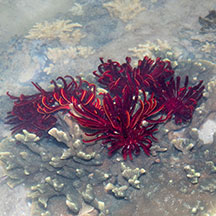 Source: wildsingapore.com
Source: wildsingapore.com
Climate change is a mega disaster for almost every living being since it has the potential to wipe everything out with disasters it can cause. Feather stars are usually perched on top of tall living or dead hard corals sponges and other sturdy anchors. Rosy Feather Star via flickrPhilippe Guillaume. Some feather stars are also toxic helping them avoid getting eaten. The Himerometra species is Nocturnal in nature and therefore hides beneath sponges corals rocks andor rock caves or any other shady region during the day time while being active at night.
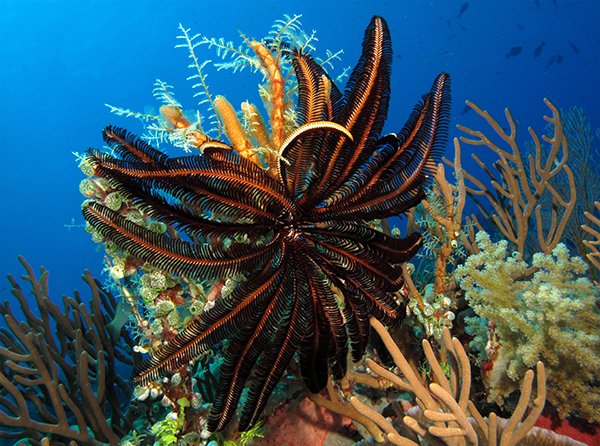 Source: australiangeographic.com.au
Source: australiangeographic.com.au
The crinoids or Feather stars are the Dendronephthya of the echinoderm world. But because small animals like snails often live on them fish may comb through feather stars looking for a tasty meal. Like brittle stars feather stars can purposely drop off an arm or two when threatened. The mouth is situated on the upper surface of the calyx. The crinoids or Feather stars are the Dendronephthya of the echinoderm world.
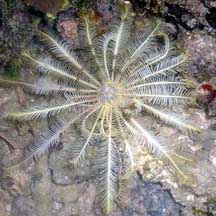 Source: wildsingapore.com
Source: wildsingapore.com
Here are five of the most beautiful species from around the world. Rosy Feather Star via flickrPhilippe Guillaume. The species Antedon bifida known as the Rosy Feather Star occurs most frequently between Scotland and Portugal. Feather stars are echinoderms like the more familiar sea stars. Feather stars have multiple arms.
 Source: australiangeographic.com.au
Source: australiangeographic.com.au
Here they extend their arms into the currents and gather food. Feather stars are usually perched on top of tall living or dead hard corals sponges and other sturdy anchors. Climate change is a mega disaster for almost every living being since it has the potential to wipe everything out with disasters it can cause. However not every single living being is feeling threatened actually. They would make striking display organisms but their specialised diets hamper success in the home aquarium.
 Source: earthbuddies.net
Source: earthbuddies.net
The bright colors displayed by many feather stars signal distasteful qualities. Feather stars can still anchor themselves to rocks and substrate if they need to using a set of tiny legs called cirri. The species Antedon bifida known as the Rosy Feather Star occurs most frequently between Scotland and Portugal. They would make striking display organisms but their specialised diets hamper success in the home aquarium. The crinoids or Feather stars are the Dendronephthya of the echinoderm world.
 Source: pinterest.com
Source: pinterest.com
They would make striking display organisms but their specialised diets hamper success in the home aquarium. All are found in the marine environment in a range of habitats from intertidal surf beaches to the deepest oceans. Also arising from this small body are the jointed arms which are usually quite short but may measure more than 118 in 30 cm in some. The dropped arm may continue to wriggle to distract the predator while the brittle star escapes. The species Antedon bifida known as the Rosy Feather Star occurs most frequently between Scotland and Portugal.
This site is an open community for users to submit their favorite wallpapers on the internet, all images or pictures in this website are for personal wallpaper use only, it is stricly prohibited to use this wallpaper for commercial purposes, if you are the author and find this image is shared without your permission, please kindly raise a DMCA report to Us.
If you find this site beneficial, please support us by sharing this posts to your preference social media accounts like Facebook, Instagram and so on or you can also save this blog page with the title are feather stars poisonous by using Ctrl + D for devices a laptop with a Windows operating system or Command + D for laptops with an Apple operating system. If you use a smartphone, you can also use the drawer menu of the browser you are using. Whether it’s a Windows, Mac, iOS or Android operating system, you will still be able to bookmark this website.